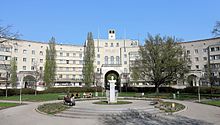Karl-Seitz-Hof
The Karl-Seitz-Hof is a large urban residential complex (a " community building ") built from 1926 to 1933, so named in 1951, with addresses Jedleseer Straße 66-94 / Voltagasse / Bunsengasse / Dunantgasse (at the time of construction: Moltkegasse) in Floridsdorf , 21 . district of Vienna . Although it is perceived as part of Jedlesee , it actually belongs to the cadastral community Großjedlersdorf II (Neujedlersdorf) . The complex, previously known as the Garden City, was a site of the civil war in 1934 and has been named after Mayor Karl Seitz , who began his political career as a member of parliament for Floridsdorf, since 1951 .
architecture
The residential complex of the municipality of Vienna, begun in 1926 and completed in 1933 according to plans by Hubert Gessner, comprises 1,173 apartments. Architecturally, with its emphasis on the horizontal, the staggered towers and the distinctive semicircular, recessed central front, in the axis of which the entrance to the courtyards is located, it corresponds to the need for representation of the Social Democrats of the First Republic for the workers it represented, which was then showed in several Viennese “superblocks”.
At the same time, the complex is considered to be a representative of the “ garden city ” type because of its structure through cleverly designed inner courtyards and its limited area . It is one of the most interesting plans of the late 1920s in Vienna and leads over to the type of the “relaxed superblock”, as it was realized in the George Washington Hof on Wienerberg in Vienna's 10th district . Edge constructions, in which barely a quarter of the available floor space was actually used for the houses, were not uncommon here in the early 1930s.
A bust depicting Seitz created by Gustinus Ambrosi was unveiled on June 16, 1951 when the complex was named after the man who died in 1950. It is located on a square base on the main square of the residential complex, which was named Karl-Seitz-Platz in 1998. In the axis of Edisongasse stands the sculpture Schreitender, created in 1951 by Wilhelm Frass and visible through the main entrance .
The 40 meter high, free-standing pyramid-shaped church tower of the Gartenstadt parish church has been part of the silhouette of the Karl-Seitz-Hof since 1964 .
In 2006 an underground car park was built.
City history
During the February uprising of 1934 against the Dollfuss dictatorship , the garden city was one of the resistance centers of the Republican Protection Association and did not fall into the hands of the government troops until February 14, 1934, after a previous bombardment by an armored train of the federal army that had hit the northwest railway track .
Karl Seitz
The complex is named after Karl Seitz , who was elected in 1901 and was the first social democratic member of the Reichsrat for the Floridsdorf district. Seitz was the first republican head of state of German Austria from 1918 to 1920 and mayor and governor of Vienna from 1923 to 1934 , until he was removed from office by the Dollfuss dictatorship. During his tenure, he realized, among other things, large social housing programs (over 63,000 apartments within a decade).
Franz Jonas
The mother of the Mayor of Vienna 1951–1965 and Federal President 1965–1974, Franz Jonas , lived for many years in a small apartment in Karl-Seitz-Hof, although her son could easily have found a larger one for her.
literature
- Felix Czeike: Vienna XXI. Floridsdorf. Viennese district culture guide . J&V, Vienna 1979, ISBN 3-7141-6221-6 .
Web links
- Municipal housing Karl-Seitz-Hof in the digital cultural property register of the City of Vienna (PDF file)
- Karl-Seitz-Hof. In: dasrotewien.at - Web dictionary of the Viennese social democracy. SPÖ Vienna (Ed.)
Coordinates: 48 ° 15 ′ 48 ″ N , 16 ° 23 ′ 13 ″ E


